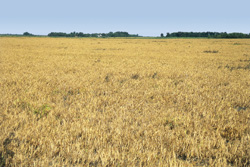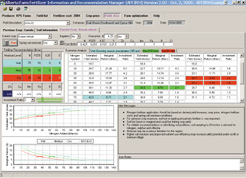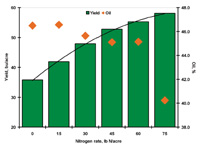
Features
Agronomy
Fertility and Nutrients
Summerfallow canola may require nitrogen fertilization
Declining organic matter levels mean lower soil fertility and less nitrogen
mineralization.
November 29, 2007 By Bruce Barker
Prairie soils used to be rich in organic matter. In fact, early reports from
1910 found that average organic matter levels in Alberta and Saskatchewan were
approximately 11.9 percent. Unfortunately, years of summerfallowing in the Brown
and Dark Brown soil zones have resulted in drastic declines. For example, the
Saskatchewan Soil Test Lab (SSTL) reported in 1994 that average soil organic
matter levels from 1945 to 1993 saw losses of 25 percent in the Brown soil zone
and 33 percent in the Dark Brown zone.
"A consequence of these losses has been a dramatic reduction in mineralizable
N in the Brown and Dark Brown soils, and that has impacted N fertility of crops
grown on fallow soils," explains Rigas Karamanos, manager of agronomy with
Westco at Calgary, Alberta.
| Figure 1. Wheat grain yield and protein response to N fertilizer rates in 2003 (left) and 2004 (right). |
|
 |

|
Prior to 1991, SSTL recommendations for fallow and stubble fields were identical.
Basically the equation was soil and fertilizer N equals a certain level of N
per acre to meet a target yield. It did not take immobilization of N into account
on stubble fields, where N is tied up and temporarily unavailable when straw
is decomposed.
After 1991, the recommendations were changed to reflect N immobilization. A
stubble field, then, received proportionately higher N fertilizer recommendations
to compensate for the N immobilization. The change at that time, though, did
not improve N fertilizer recommendations for summerfallow. However, today's
soil test recommendations do a better job of estimating mineralizable N on summerfallow
fields.
Supporting Karamanos' observations is the Alberta Fertilizer Guide, published
by Alberta Agriculture, Food and Rural Development (AAFRD). It says that soil
test recommendations in Alberta now indicate 20 pounds of fertilizer N per acre
or more is required on 30 to 40 percent of fallow fields in the province. While
the amount varies from field to field and year to year, there is no doubt that
the decline in soil fertility means all farmers should pay close attention to
fertilizer recommendations.
| Figure 2. Canola grain yield and protein response to N fertilizer rates in 2003 (left) and 2004 (right). |
|
 |

|
New research shows summerfallow canola very responsive
To address these deficiencies, Karamanos, along with Fernando Selles at Agriculture
and Agri-Food Canada at Swift Current, set up a three year project in 2003 to
assess N fertilizer needs of canola and wheat grown on fallow fields. The first
two years of results are in, with 2005's results pending.
The project is being conducted on three sites in Alberta at Hussar, Bassano
and Gleichen; and three sites in Saskatchewan at Bulin, Stewart Valley and the
AAFC South Farm. The N rates for canola are zero, 15, 30, 45, 60 and 75kg/ha
and wheat rates are zero, 10, 20, 30, 40 and 50kg nitrogen per hectare.
The objectives are to determine yield, protein and/or oil responses to N application.
The first two years of the study showed very good response to fertilizer N.
In 2003, a very dry year, response to N fertilizer was more limited than in
2004 when yield response under very good moisture conditions was very high.
Karamanos also found that as yields increased, oil content decreased. However,
since farmers are mainly paid for yield and not oil content, the decline is
acceptable on a farm income basis.
The interim results of the study support the need for a closer look at N fertilizer
rates on summerfallow. Lower soil test N levels, combined with lower organic
matter and lower mineralization mean canola and wheat grown on summerfallow
are likely lacking in N fertility, unless N fertilizer is applied.
Under dry conditions, the research project found that maximum yield response
was in the range of 70kg/ha to 75kg/ha (62lb/ac to 67lb/ac) of soil and applied
N fertilizer. In the above normal moisture conditions of 2004, the soil and
applied N fertilizer was in the range of 95kg/ha to 105kg/ha of nitrogen (85lb/ac
to 93lb/ac).
To put this knowledge to practice, farmers should carefully consider their
soil test recommendations, target yield and the amount of expected moisture
during the growing season. Work with an agronomist to determine the best fertilizer
recommendations, based on soil tests, soil moisture and probability of receiving
growing season precipitation. Do not just assume that N fertilizer is not required.
"We have the tools to assess N fertility and the need for N fertilizer
on summerfallow fields," says Karamanos. "We're just running out of
organic matter and need to increase N fertilizer on summerfallow."
| Table 1. Control yields and maximum yield increases of wheat grain with the corresponding rates of N. |
||||||||||
| – | 2003 | 2004 | ||||||||
| Site | Control yield | Rate | Yield increase | Control yield | Rate | Yield increase | ||||
| – | Kg ha-1 | bu/ac | – |
kg ha-1 |
bu/ac |
kg ha-1 |
bu/ac | – |
kg ha-1 |
bu/ac |
| Hussar | 1743 | 25.9 | 0 | 0 | 0.0 | 3454 | 51.4 | 0 | 0 | 0.0 |
| Bassano | 1688 | 25.1 | 40 | 453 | 6.7 | 2755 | 41.0 | 20 | 606 | 9.0 |
| Gleichen | 2133 | 31.7 | 40 | 659 | 9.8 | 3663 | 54.5 | 40 | 965 | 14.4 |
| Bulin | 982 | 14.6 | 10 | 315 | 4.7 | 1127 | 16.8 | 50 | 1515 | 22.5 |
| South Farm | 1957 | 29.1 | 0 | 0 | 0.0 | 2798 | 41.6 | 40 | 696 | 10.4 |
| Stewart Valley | 2456 | 36.6 | 10 | 129 | 1.9 | 2791 | 41.5 | 50 | 745 | 11.1 |